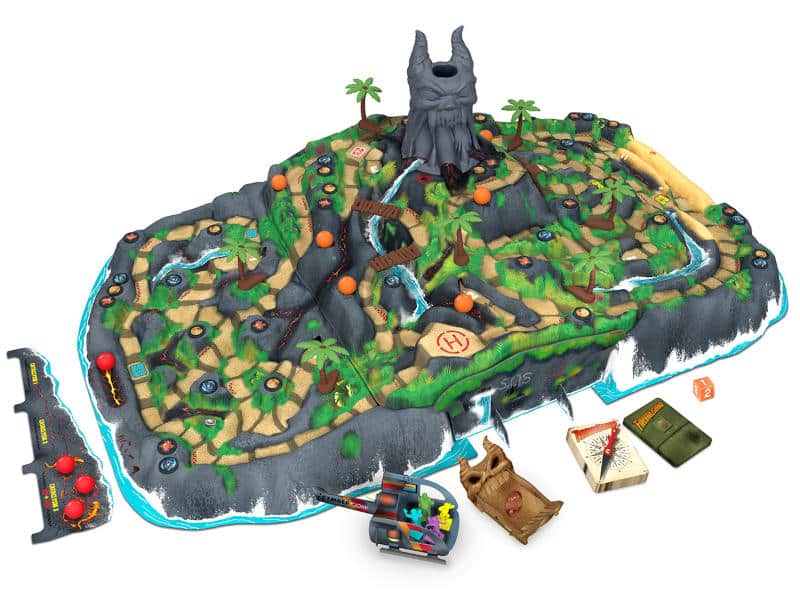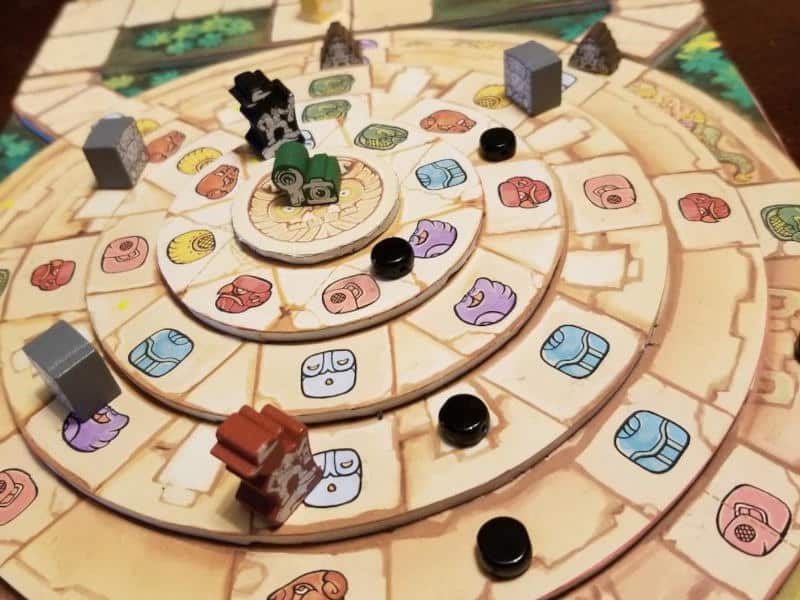Hi, it’s Joe Slack here. Oliver was kind enough to let me write another guest blog and was excited to hear my thoughts as a game designer and indie publisher on why table presence matters for board games. So, let’s get into it.
There are so many board games released every single year. On Kickstarter alone, 4,042 tabletop campaigns reached their funding goal in 2022, up from 3,520 the year before. Essen Spiel alone saw about 1,200 new releases this year (2023). That doesn’t include all the new releases at Gen Con, Origins and other gaming conventions, not to mention games being released directly to retail.
Sure, some of these numbers include expansions, releases in other languages and various other gaming-adjacent projects like dice, tables and game bags, but we’re likely still looking at 5,000+ games being released in a single year.
That’s a lot of choice. So, what’s a gamer to do? How do you choose what to play and what will stay?
Well, one determining factor is table presence.
Table presence simply means that the game looks great on the table and attracts attention. This can be accomplished through the use of large or unique components, amazing artwork or anything else that really catches the eye.
If a game looks great and stands out from all the others, it stands a better chance of drawing you in, getting you to ask questions and wanting to play.
So, let’s take a look at some games that accomplish this goal of having a great table presence.

Examples of Great Table Presence
One of the first games that comes to my mind with great table presence is Fireball Island: The Curse of Vul-Kar. I mean, this game really has it all when you talk about table presence. You’ve got a huge moulded island, plastic trees and bridges and a scary oversized head at the top that spits out marbles to knock players down. This game also has a lot of nostalgia, as the original was released in the 1980s and Restoration Games brought it back to life and modernized it with some new mechanics.
Want to make a memorable game? Why not put a giant tree in it? That’s exactly what Everdell did and it’s done pretty well for itself. But I’m sure that the beautiful art, along with the gameplay had something to do with that as well. It’s got an impressive 8.0 rating out of 10 on Board Game Geek (BGG) and ranks #32 amongst all games ever made. So, in this case, the table presence may bring you in, but the game itself keeps you coming back for more.
On the other end of the spectrum, we have the infamous 1963 game Mousetrap. It doesn’t rank nearly as high on BGG, with a measly 4.1 rating and very few ratings above 7. The BGG tagline says “Roll-and-move mice meet a real-life Rube Goldberg contraption!” and that pretty much sums it up. Mousetrap may even be considered more of an activity (sometimes in frustration) than a game, as you spend so much time putting everything together in hopes that it will actually work right and not get stuck somewhere in the procession of items dropping and flipping around.
Classic Success
However, that didn’t stop Mousetrap from becoming a huge success. I wasn’t able to find much in the way of sales data, but I did discover that it sold 1.2 million copies in its first year alone (1963), likely meaning it has sold in the tens of millions since then, so the game did pretty well for itself.
The Climbers is another game that comes to mind. I remember seeing this at Origins Game Fair several years ago and wondering what this game with building blocks and ladders was. The toy and building factor is pretty big on this one and it definitely gets people’s attention the higher it gets built up.
Next up, is the Dark Tower. This is another classic game that Restoration Games reestablished. I haven’t played this one myself but I’ve seen it on the table and definitely said, “Whoa, what’s that?” when I did. There is even a small computer inside the tower that will play music and keep track of inventory. Pretty neat.
Whether you’re a fan of any of these games or not, you have to admit they do get your attention.
There are plenty of other games with great table presence out there as well. This is just a short list of some that made me stop in my tracks.

Incorporating Table Presence In My Own Games
As a game designer facing the aforementioned challenge of competing against thousands of other game releases every year, I’ve definitely tried to keep table presence in mind when I’m working on a game. Of course, it doesn’t hurt that the co-designer I usually work with prioritizes this from a very early stage!
However, it’s not good enough for a game to just look good. It has to play well and have strong replayability. As I said with the example of Everdell, the look of the game draws people in, but it is the gameplay that keeps them coming back for more.
When I was designing Relics of Rajavihara, I intended to create a game that was attractive to the eye and got your attention. Stacking and moving wooden crates and blocks around is something you definitely don’t see every day in a board game. Yet, this is recognizable from some video games, so there is also some familiarity, which is usually a good thing.
But I also wanted to evoke surprise and curiosity, which is why each floor comes with its own tuck box. When you open it, you discover a brand new type of block that functions differently from what you’ve previously experienced.
So, I guess you could also say I was going for box presence as well!
Sliding Slabs and Rotating Temples
With our latest game, Mayan Curse, I could tell from a very early stage that it was going to be the type of game that would have people do a double-take. From the sliding slabs to the rotating temple to the Indiana Jones-like feeling of adventure, we tried to bring out that table presence in every component.
Of course, the gameplay had to deliver on that promise of a great adventure game as well. It took years of adding and removing modules to the board trying to get the puzzle-yness and tension just right, tweaking the rules and objectives to make it challenging yet balanced, and playtesting with dozens of different groups to ensure the right feeling was captured.
If you’re interested in learning more about Mayan Curse, you can check it out on Kickstarter. Mayan Curse will be live on Kickstarter between 24 October and 17 November 2023.
Thanks again Oliver for letting me join you for this guest post!
Useful Links
- Kickstarter: https://www.
kickstarter. com/ - Essen Spiel: https://www.
spiel-essen. de/ en/ - Gen Con: https://www.
gencon. com/ - Origins Game Fair: https://www.
originsgamefair. com/ - Fireball Island: The Curse of Vul-Kar: https://restorationgames.
com/ fireball-island/ - Everdell: https://www.
tabletoptycoon. com/ products/ everdell-collectors-edition-3rd-edition - Board Game Geek: https://boardgamegeek.
com/ - Mousetrap: https://products.
hasbro. com/ en-gb/ product/ mouse-trap-game/ 7EA54149-5056-9047-F5A2-33F4578345CC - The Climbers: https://capstone-games.
com/ the-climbers - Dark Tower: https://restorationgames.
com/ return-to-dark-tower/ - Relics of Rajavihara: https://www.
crazylikeabox. com/ relics-of-rajavihara/ - Mayan Curse crowdfunding page: https://www.
kickstarter. com/ projects/ crazylikeabox/ mayan-curse
Audio Version
Intro Music: Bomber (Sting) by Riot (https://www.
Music: “Chill Hip Hop” by AShamaluevMusic.
Website: https://www.


There’s a lot of toyification in boardgames, which is not always a bad thing, especially if it’s more than a gimmick. Like you said, the gameplay matters. So while Mouse Trap has sold well, it’s also not a game that is played very often once owned, except maybe to play with it as a toy. At least, that’s what I did when I was a kid.
Also, bigger is not always better as I’ve had to pass on games due to the amount of space they take up. I don’t have a large table so it doesn’t matter how toyified or pretty a game is if it’s going to be a struggle to fit it on my table.
So the kind of table presence desired is going to be different for different people. I prefer smaller games with eye-catching art over large games with big plastic pieces that play music. I’ll leave those games to others to enjoy.
Hello Sarah. Thank you so much for your comments. I agree that finding a balance between including the toy factor in games without it just being a gimmick.